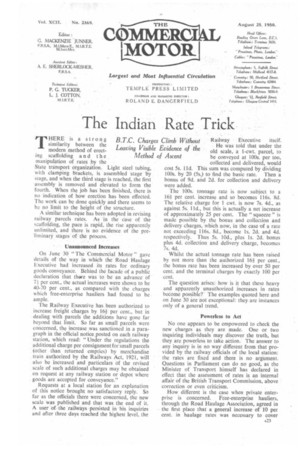The Indian Rate Trick
Page 25

Page 26

If you've noticed an error in this article please click here to report it so we can fix it.
THERE is a strong similarity between the modern method of erecting scaffolding and the Method of Ascent manipulation of rates by the
B.T.C. Charges Climb Without Leaving Visible Evidence of the
State transport organization. Light steel tubing, with clattipiq brackets, is assembled stage by stage, and when the third stage is reached, the first assembly is removed and elevated to form the• fourth. When the job has been finished, there is no indication of how erection has been effected. The work can be done quickly and there seems to be no limit to the height of the structure.
A similar technique has been adopted in revising railway parcels rates. As in the case of the scaffolding, the pace is rapid, the rise apparently unlimited, and there is no evidence of the preliminary stages of the process.
• Unannounced Increases On June 30 "The Commercial Motor" gave details of the way in which the Road Haulage Executive had increased its rates for ordinary goods conveyance. Behind the facade of a public declaration that thece was to be an advance of 71 per cent., the actual increases were shown to be 40-70 per cent., as compared with the charges which free-enterprise hauliers had found to be ample.
The Railway Executive has been authorized to increase freight charges by 16i per cent., but in dealing with parcels the additions have gone far beyond that limit. So far as small parcels were concerned, the increase was sanctioned in a paragraph in the official notice posted on each railway station, which read: "Under the regulations the additional charge per consignment for small parcels • (other than returned empties) by merchandise train authorized by the Railways Act, 1921, will also be increased and particulars Of the revised scale of such additional charges may be obtained on request at any railway station or depot where goods are accepted for conveyance."
Requests at a local station for an explanation of this notice brought no satisfactory reply. So far as the officials there were concerned, the new scale was published and that was the end of it. A user ofthe railways persisted in his inquiries and after three days reached the highest level, the Railway Executive itself.
He was told that under the old scale, a 1-cwt. parcel, to be conveyed at 100s. per ton. collected and delivered, would cost 5s. 1 ld. This sum was computed by dividing 100s. by 20 (59 to find the basic rate. Then a bonus of 9d. and 2d. for collection and delivery were added.
The 100s. tonnage rate is now subject to a 16i per cent. increase and so becomes 116s. 8d. The relative charge for 1 cwt. is now 7s. 4d., as against 5s. lid., but this is actually a net increase of approximately 25 per cent. The " squeeze " is made possible by the bonus and collection and delivery charges, which now, in the case of a rate not exceeding 116s. 8d., become Is. 2d. and 4d. respectively. Thus 5s. 10d., plus is. 2d. bonus plus 4d. collection and delivery charge, becomes 7s. 4d.
Whilst the actual tonnage rate has been raised by not more than the authorized 163. per cent., the bonus rate has been increased by over 50 per cent. and the terminal charges by exactly 100 per cent.
The question arises: how is it that these heavy and apparently unauthorized increases in rates become possible? The examples quoted here and on June 30 are not exceptional: they are instances only of a general trend.
Powerless to Act No one appears to be empowered to check the new charges as they are made. One or two inquiring individuals may discover the truth, but they are powerless to take action. The answer to any inquiry is in no way different from that provided by the railway officials of the local station: the rates are fixed and there is no argument. Questions in Parliament can do no good, as the Minister of Transport himself has declared in effect that the assessment of rates is an internal affair of the British Transport Commission, above correction or even criticism.
How different is the case when private enterprise is concerned. Free-enterprise hauliers, through the Road Haulage Association, agreed in the first place that a general increase of 10 per cent. in haulage rates was necessary to cover additions to the cost of operation arising from the doubling of the fuel tax, the imposition of purchase tax, and the rise in the costs of tyres and fuel. That decision could be discussed between hauliers and their customers, and, usually, careful examination of the particular circumstances enabled the increase to be limited to 7i per cent. There was no attempt by carefully worded paragraphs or clauses in agreements to raise the 7l per cent. even to n per cent.
That, it seems, is the difference between the two forms of trading—Government monopoly and free enterprise. As in the case of the scaffolding, there seems to be no limit to the height to which rates imposed by the B.T.C. can be elevated, despite a theoretical restriction.
What, then, becomes of the assertions made by Sir Stafford Cripps and his Government associates that the increase in the cost of fuel and the addition of purchase tax will have 'a negligible effect on commodity prices? With the cost of transport going up by 40 per cent. and even 100 per cent., it is impossible for commodity prices to remain undisturbed.












































































